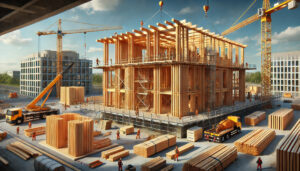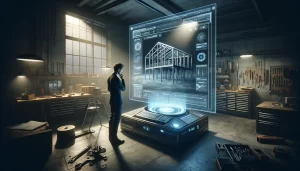The Future of Residential Construction
The Growing Role of Steel - Explore how steel is shaping modern residential construction, focusing on innovation and sustainability
The construction industry is constantly evolving, seeking new materials and techniques to improve efficiency, sustainability, and durability of residential buildings. In recent years, steel has been gaining traction as a primary material in residential construction, and its influence is expected to grow significantly in the future. This article will delve into the reasons why steel is set to play a greater role in residential building, why it is necessary to replace wood, and the impact it will have on the future of the construction industry.
The Rise of Steel in Residential Construction
Strength and Durability
Steel is renowned for its exceptional strength and durability, making it an ideal material for residential construction. Compared to wood, steel offers a higher strength-to-weight ratio, meaning it can support greater loads with less material. This characteristic allows for more open and flexible floor plans, providing architects and builders with increased design freedom.
Steel’s durability also ensures that residential buildings can withstand the test of time, requiring minimal maintenance and reducing the need for costly repairs over the long term. The strength and durability of steel make it a reliable choice for homeowners and builders alike.
Resistance to Environmental Factors
Steel is highly resistant to environmental factors such as fire, termites, mold, and rot, which are common concerns associated with wood. This resilience makes steel an attractive choice for residential construction, especially in areas prone to natural disasters or where pest infestation is a significant issue.
With the increasing prevalence of wildfires and extreme weather events attributed to climate change, the use of steel in residential construction offers enhanced protection against these environmental hazards, thereby ensuring the safety and longevity of buildings. The resistance of steel to environmental factors provides homeowners with peace of mind and reduces the need for costly repairs and replacements.
Sustainability and Recyclability
As the world continues to prioritize sustainability, steel stands out as an eco-friendly building material. It is fully recyclable and can be reused without losing its inherent properties. According to the Steel Recycling Institute, steel is the most recycled material on the planet, with a recycling rate higher than 90%. This not only reduces the demand for new raw materials but also minimizes waste, making steel a sustainable choice for residential construction.
The recyclability of steel contributes to a circular economy, promoting resource efficiency and reducing the environmental impact of construction activities. By choosing steel over wood, the construction industry can play a significant role in conserving natural resources and mitigating the carbon footprint of residential buildings. The sustainability of steel aligns with the global push for environmentally friendly practices and supports the long-term well-being of the planet.
Long-Term Cost Savings
While the initial cost of steel may be higher than wood, its longevity and minimal maintenance requirements result in long-term cost savings. Steel-framed homes require less frequent repairs and replacements compared to their wood-framed counterparts, leading to reduced maintenance expenses over the lifetime of the building.
The long-term financial benefits of using steel in residential construction are further amplified by its resilience to environmental factors, which minimizes the risk of damage and the associated repair costs. Homeowners can enjoy the peace of mind that comes with lower maintenance expenses, while builders and developers can reap the financial rewards of reduced long-term costs.
The Need to Replace Wood with Steel
Environmental Impact
The use of wood in residential construction has raised concerns about deforestation and its impact on the environment. In contrast, steel production does not require the depletion of natural forests, making it a more sustainable choice for residential construction.
By transitioning from wood to steel, the construction industry can contribute to the preservation of forests, which are vital for biodiversity, carbon sequestration, and the overall health of the planet. This shift aligns with global efforts to combat deforestation and promote responsible land use practices. Choosing steel over wood demonstrates a commitment to environmentally conscious practices and supports the conservation of natural resources.
Safety and Stability
Steel offers superior safety and stability compared to wood. In regions susceptible to earthquakes, hurricanes, or wildfires, steel-framed homes provide better protection against structural damage and collapse, enhancing the overall safety of residential buildings.
The heightened safety and stability of steel-framed homes not only protect occupants during natural disasters but also reduce the risk of costly structural failures, thereby ensuring the long-term integrity of residential buildings. By prioritizing safety and stability, builders can provide homeowners with a secure living environment and protect their investment in the property.
Addressing the Housing Crisis
With a growing global population and increasing urbanization, the demand for affordable and durable housing continues to rise. Steel presents a viable solution to address the housing shortage by providing cost-effective, resilient, and long-lasting residential structures.
The utilization of steel in residential construction supports the development of affordable housing options, contributing to the creation of sustainable and livable communities for individuals and families in need of housing. By embracing steel as a primary building material, the construction industry can play a crucial role in meeting the housing needs of communities around the world.
Advancements in Steel Manufacturing
Technological advancements in steel manufacturing have made the material more accessible and cost-effective. Innovations in production processes have led to the development of high-strength steel alloys, further enhancing the structural capabilities of steel in residential construction.
The continuous evolution of steel manufacturing techniques and materials underscores the industry’s commitment to innovation and improvement, ensuring that steel remains a competitive and reliable choice for residential building projects. These advancements in steel manufacturing not only make it easier for builders to incorporate steel into their projects but also expand the possibilities for architectural design and structural engineering.
The Impact on the Future of Residential Construction
Design Flexibility
Steel’s superior strength and flexibility allow for larger open spaces and more creative architectural designs. This versatility enables architects to push the boundaries of traditional residential construction, leading to innovative and aesthetically pleasing homes.
The design flexibility offered by steel empowers architects and builders to create residential spaces that are not only visually striking but also functional, adaptable, and tailored to the evolving needs of homeowners. From open-concept layouts to unique geometric shapes, steel provides endless possibilities for architectural expression.
Rapid Construction
Steel-framed construction offers faster build times compared to traditional wood framing. The use of prefabricated steel components and modular construction techniques accelerates the building process, reducing overall construction timelines and costs.
The expedited construction timelines associated with steel framing contribute to the timely delivery of residential projects, meeting the growing demand for housing while optimizing resource allocation and project management. Builders can complete projects more efficiently, allowing homeowners to move into their new residences sooner.
Enhanced Resilience
As climate change continues to pose challenges to residential infrastructure, the resilience of steel-framed homes becomes increasingly important. Steel’s resistance to extreme weather events and environmental hazards ensures that residential buildings can withstand the test of time and environmental pressures.
The enhanced resilience of steel-framed homes promotes the long-term sustainability of residential communities, providing occupants with a sense of security and stability in the face of changing environmental conditions. By building with steel, homeowners can have confidence in the durability of their homes, even in the face of adversity.
Sustainable Development
The adoption of steel in residential construction aligns with the global push for sustainable development. By choosing steel over wood, builders contribute to the conservation of forests and reduce the environmental impact of construction activities, promoting a greener and more sustainable future for residential building.
The integration of steel into residential construction practices supports the transition towards sustainable urban development, fostering environmentally conscious building practices and contributing to the overall resilience of urban infrastructure. By embracing steel as a building material, the construction industry can pave the way for a more sustainable and environmentally friendly future.
Call to Action
For more information on the growing role of steel in residential construction and to stay updated on the latest industry trends, follow us on Facebook, Instagram, and LinkedIn. Visit our website to access a wealth of resources, articles, and insights on how steel is shaping the future of residential building.
In conclusion, the future of residential construction is poised for a significant transformation, with steel emerging as a pivotal material driving innovation, sustainability, and resilience in the industry. By embracing steel as a primary building material, the construction sector can usher in a new era of durable, eco-friendly, and cost-effective residential structures that meet the evolving needs of communities around the world. With its strength, durability, resistance to environmental factors, and sustainability, steel is set to play an increasingly important role in shaping the future of residential construction.




